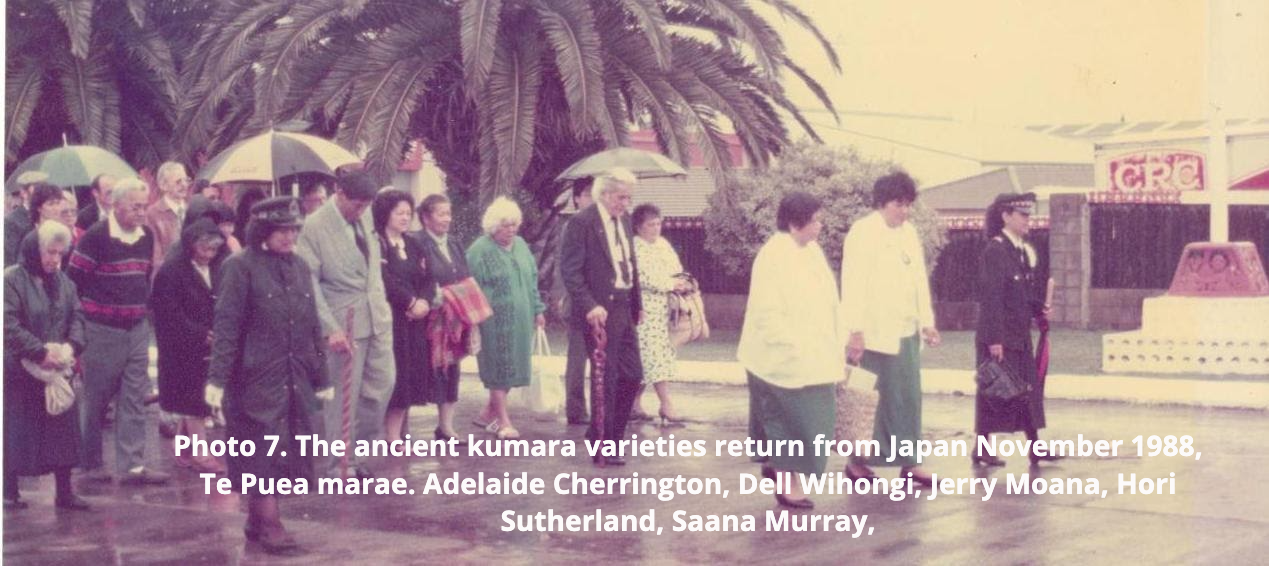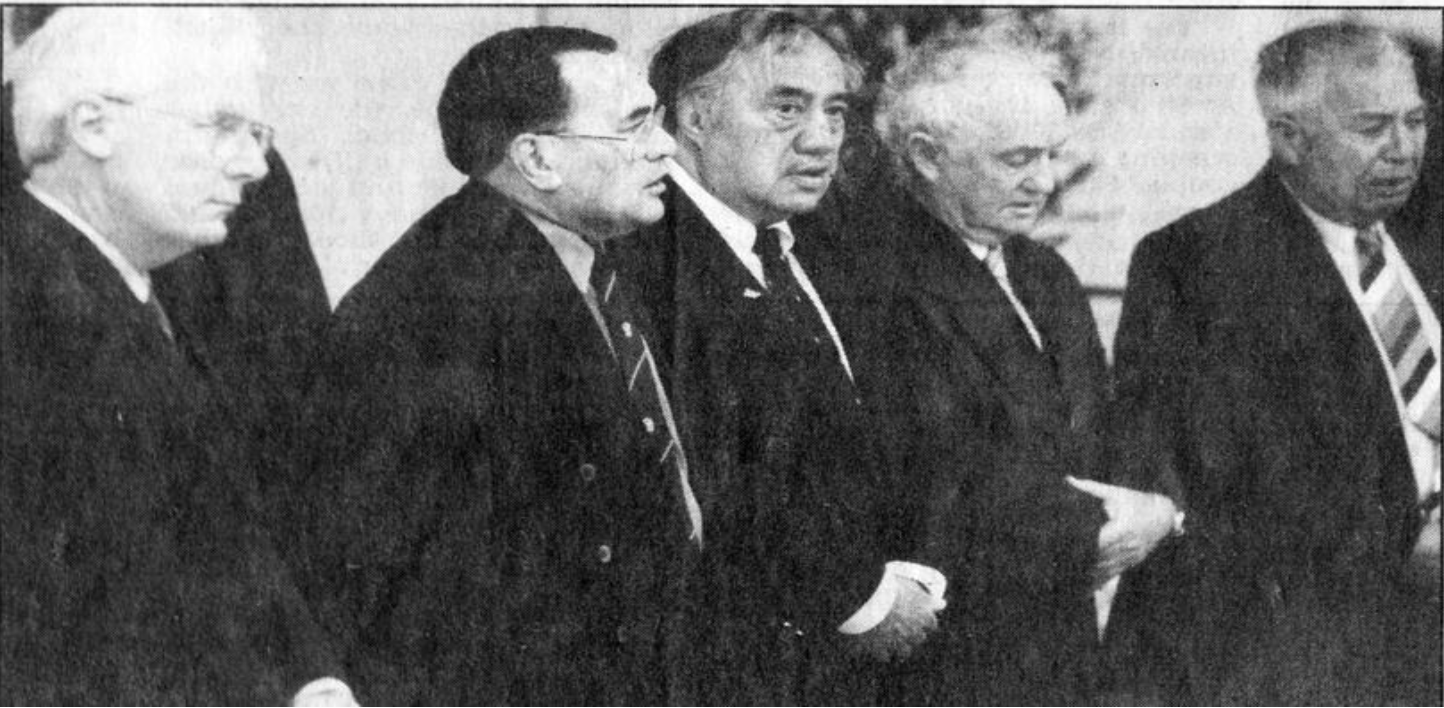1980 to 1989
1980
The Social Responsibility of DSIR at Mt Albert was published by Oliver Sutherland and others, arguing for greater responsiveness of government science agencies, particularly DSIR, to the needs of Māori. It was the first challenge to the monocultural policies of the department.
1983
Warwick Harris and Murray Parsons of DSIR's Botany Division established a relationship with weaver Cath Brown (Ngāi Tahu, Taumutu Marae, Te Wai Pounamu) and the ‘Aotearoa Moananui-a-Kiwa Weavers’ (including Saana, Emily Schuster, Diggeress Te Kanawa and Te Aue Davis) particularly to ensure conservation of harakeke, pīngao and kiekie and to protect and promote traditional knowledge regarding the arts and crafts which utilized these plants. A year later, in 1984, DSIR botanists attended a weavers’ hui at Te Teko which focused on the availability of plants traditionally used for weaving, and on access to those plants.
1985
Māori leaders from the north, including Saana Waitai-Murray, Carmen Kirkwood, Nganeko Minhinnick, Titewhai Harawira, Hon. Matiu Rata, Jim Nichols, Sir Hugh Kawharu, Rev. Māori Marsden, Dr Ranginui Walker, Neville Baker, Sir Norman Perry and Pita Rikys, met for the first time ever with Director General and other senior leaders of DSIR at Mt Albert, at a hui jointly organised by Sir Graham Latimer and Oliver Sutherland. The hui aimed at bridging the gulf between Māori and the scientific community and focused on ways in which government science agencies, particularly DSIR, might direct some of their efforts towards issues of importance to Māori, especially the utilization of land to provide work and income for some impoverished rural communities. For the first time, DSIR acknowledged that its functions and activities should be based on the principles of The Treaty of Waitangi.
1987
Plant Variety Rights Act passed, opening the way for commercial plant breeders to gain proprietary rights to ‘new’ varieties of native species
1988
22-28 February: Commonwealth Science Council Hui on Ethnobotany, Ngā Mahi Māori o te Wao Nui a Tane, was held at Rēhua Marae, Christchurch.
The five-day, landmark, International Workshop on the Traditional Uses of Plants brought Saana Murray (of Te Hāpua Traditional Arts and Crafts Trust), Dell Wihongi (of the Pu Hao Rangi Trust) and John Hippolite all together for the first time, along with two hundred other māori, Pacifica and Commonwealth kaumātua and leaders. It was organized by Warwick Harris, Murray Parsons, Geoff Walls and Oliver Sutherland, all of DSIR, and Promila Kapoor, of the Commonwealth Science Council. The hui showcased Barry Barclay’s film The Neglected Miracle, which exposed the commercial exploitation by multi-national seed and horticultural companies of traditional plant varieties, particularly those from South America. The hui also revealed publicly the fate of ancient kūmara, especially DSIR’s sale of the large collection of kūmara varieties assembled by Dr Douglas Yen, to a research institution in Tsukuba, Japan. Both Saana and Dell voiced their concerns at the risks to traditional knowledge and at the commercial exploitation of native plants.
The hui recommended:
- the principle that science must flourish for the benefit of all people, not for the profit of a few;
- the conservation of species of importance to Māori and other indigenous people, and the retention and protection of traditional knowledge regarding the utilization of these species;
- the need for consultation with Māori prior to any further commercial exploitation of native plant species;
November: Dell Wihongi led an ope including Jerry Moana, Adelaide Cherrington and Hori Sutherland, representing the Pu Hao Rangi Trust, to Japan to retrieve nine of the ancient kūmara varieties transferred from DSIR to Japanese researchers at Tsukuba Science City in 1964.
Their mission was ridiculed by politicians who refused to support it, as did other conservation organisations. In the end, the well-known TV botanist Dr David Bellamy provided funding for the trip and was present when the kūmara were welcomed home at Te Puea Marae in late November 1988.
1989
March: Following concerns over the ‘patenting’ of native species under the new Plant Variety Rights Act (e.g. pohutukawa ‘Carousel’) and the activities of DSIR in the international commercialization of a number of native species, especially koromiko, mānuka and puawānanga, Murray Parsons, Oliver Sutherland and John Hippolite met with Moana Jackson at Ngā Kaiwhakamārama I Ngā Ture in Wellington to discuss ways of protecting native plants and animals and their genetics as well as the traditional knowledge pertaining to them.
John discussed the issue with his army and trade union mates, Tama Poata and Witi McMath, both of whom had long had concerns regarding the actions of the Crown in alienating ancestral land and ‘managing’ threatened and non-threatened native species in their rohe. Witi for years had challenged the Crown regarding its confiscation of Hauturu (Little Barrier Island), and the eviction of the island’s tangata whenua, to turn it into a reserve for tuatara.
Photo 8. Ngāti Wai Trust Board Hearing 17.09.1997, Crown counsel Brendan Brown, Dave Para, Eru Manuera, tribunal Judge Richard Kearney and kaumātua Bishop Manu Bennett
Meanwhile, Tama had actively pursued tino rangatiratanga issues since the early 1970s through his roles with the Māori Organisation On Human Rights and Te Roopu Matakite o Aotearoa, and was also concerned in general about the creeping (and sometimes not so creeping) erosion of Māori rights by the Crown through legislation and executive power unfettered by any deference to Māori tino rangatiratanga, as guaranteed by the Treaty. Saana, Dell and Kataraina Rimene (who represented Ngāti Kahungunu on the original claim) were equally concerned over Crown control of access to, and commercialisation of, taonga plant species. Prohibitions on the ‘cultural harvest’ of traditional foods such as kereru and kūaka, and the appropriation of ancestral lands by the Crown to create ‘reserves’ to conserve species such as the flax snail, pūpū harakeke, was a major concern for Saana.
Moana Jackson began drafting WAI 262 in March 1989; Claimants: Saana Murray, Dell Wihongi, Witi McMath, Tama Poata, Kataraina Rimene, John Hippolite. Each claimant to focus on one particular area of interest/species as the basis for a co-coordinated claim. The six claimants acted collectively, but as individuals, not representing their various iwi. In most, cases their own iwi were skeptical over the claim, as were other iwi, even though it was a claim which would benefit ngā iwi katoa.




